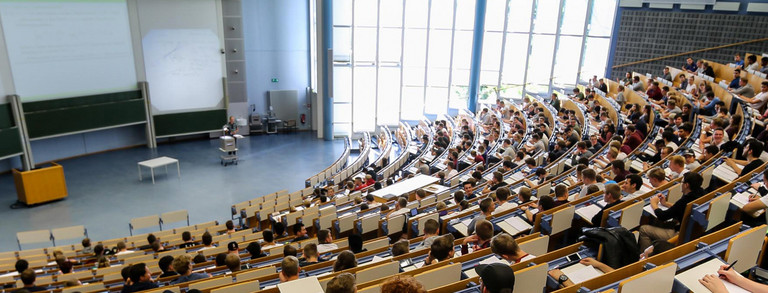The campus of TU Dortmund University is located close to interstate junction Dortmund West, where the Sauerlandlinie A 45 (Frankfurt-Dortmund) crosses the Ruhrschnellweg B 1 / A 40. The best interstate exit to take from A 45 is “Dortmund-Eichlinghofen” (closer to South Campus), and from B 1 / A 40 “Dortmund-Dorstfeld” (closer to North Campus). Signs for the university are located at both exits. Also, there is a new exit before you pass over the B 1-bridge leading into Dortmund.
To get from North Campus to South Campus by car, there is the connection via Vogelpothsweg/Baroper Straße. We recommend you leave your car on one of the parking lots at North Campus and use the H-Bahn (suspended monorail system), which conveniently connects the two campuses.
TU Dortmund University has its own train station (“Dortmund Universität”). From there, suburban trains (S-Bahn) leave for Dortmund main station (“Dortmund Hauptbahnhof”) and Düsseldorf main station via the “Düsseldorf Airport Train Station” (take S-Bahn number 1, which leaves every 15 or 30 minutes). The university is easily reached from Bochum, Essen, Mülheim an der Ruhr and Duisburg.
You can also take the bus or subway train from Dortmund city to the university: From Dortmund main station, you can take any train bound for the Station “Stadtgarten”, usually lines U41, U45, U 47 and U49. At “Stadtgarten” you switch trains and get on line U42 towards “Hombruch”. Look out for the Station “An der Palmweide”. From the bus stop just across the road, busses bound for TU Dortmund University leave every ten minutes (445, 447 and 462). Another option is to take the subway routes U41, U45, U47 and U49 from Dortmund main station to the stop “Dortmund Kampstraße”. From there, take U43 or U44 to the stop “Dortmund Wittener Straße”. Switch to bus line 447 and get off at “Dortmund Universität S”.
The AirportExpress is a fast and convenient means of transport from Dortmund Airport (DTM) to Dortmund Central Station, taking you there in little more than 20 minutes. From Dortmund Central Station, you can continue to the university campus by interurban railway (S-Bahn). A larger range of international flight connections is offered at Düsseldorf Airport (DUS), which is about 60 kilometres away and can be directly reached by S-Bahn from the university station.
The H-Bahn is one of the hallmarks of TU Dortmund University. There are two stations on North Campus. One (“Dortmund Universität S”) is directly located at the suburban train stop, which connects the university directly with the city of Dortmund and the rest of the Ruhr Area. Also from this station, there are connections to the “Technologiepark” and (via South Campus) Eichlinghofen. The other station is located at the dining hall at North Campus and offers a direct connection to South Campus every five minutes.
The facilities of TU Dortmund University are spread over two campuses, the larger Campus North and the smaller Campus South. Additionally, some areas of the university are located in the adjacent “Technologiepark”.
Site Map of TU Dortmund University (Second Page in English).

You are here:
WiSe&SoSe2023, 1 SWS, 1,5 LP, Veranstaltungs-Nr. 061181, Freitags 13-14 Uhr, SR 520 GII
An introduction into scientific research methods (e.g. search of literature and its archiving, suitable data bases, Pubmed, Google Scholar, preprints...) as well as into methods of scientific work (e.g. citation styles, availability of publications, FAIR rules) will be given. Each week, all participants will then present a self-chosen publication in a short talk (~2-3 minutes).
Skills:
Students will be able to conduct effective literature research and to summarise contents of even complex studies in a concise but coherent manner. Through contributions of other participants, students will be exposed to a wide range of topics of current research in the field.
SoSe2023, 2 SWS, 3 LP, Veranstaltungs-Nr. 061182 - Kickoff Dienstag 11.4.2023 16-18 GII, 520
Motivation: Latest progresses in sequencing technologies made genomic resources thrive, which is demonstrated for example by large-scale genome-projects for vertebrates (Bird 20K, Bat 1K). In the near future, reference genomes for almost all species may be available. But what can we learn about the genetic diversity of the entire species from the genome of a single individual? In order to answer this question, the project aims to understand which genetic diversity is captured in vertebrate reference genomes.
Approach: Participants will examine a single, self-chosen genome of a species. Afterwards, the single genome results will be compiled via a platform and jointly evaluated. The aim is to include as many ('swarm') genomes into the analysis as possible.
Skills:
Project: The project is entirely computer-based and can be conducted online. Content will cover areas of population genetics, molecular evolution and data mining of biological data. The module will start with an introduction to genome sequencing and relevant population genetic methods. Participants will then analyse the genome of a self-selected species under supervision. Results obtained from the individual species will then be merged and analyzed on a platform.
WiSe2023, 2SWS, 3 LP, Veranstaltungs-Nr. 061180, Freitags 14-16 Uhr, CT Zentralbereich SR ZE 04
This seminar will provide an overview of core topics in evolutionary genetics. Seminar content will be discussed using selected literature, scientific publications, and practical assignments. Contents are composed as follows:
Introduction/Overview / Models of Evolution /Genetic Variation / DNA Sequencing incl. modern sequencing methods / Recombination / Demography / Phylogenetics / Selection I / Selection II / Speciation / Epigenetics / Metagenomics / Ancient DNA / Genomic Scans / Summary
Skills:
Basics of evolutionary genetics will be taught.
coming in WiSe2024
coming in WiSe2025
